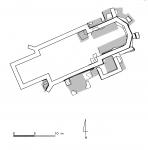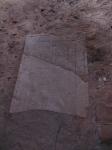Summary (English)
Systematic archaeological and conservation research of the medieval church of St. Martin at Prozorje near Dugo Selo has been conducted by the Institute of Archaeology since 2002. The church is located on top of a partially walled hill in the village of Prozorje. The average altitude of the site is 203-204 m, which makes it a hundred meters higher than the surrounding plains. The oldest visible above-ground remains of the building date from the middle of the 16th century. The church was later rebuilt and extended several times. It is single-nave, with a somewhat narrower, today three-sided sanctuary. A bell tower was added to the west side. Today’s condition of the church remains is extremely bad. The sanctuary of the church and its surroundings, as well as the eastern corners of the nave and the area south of it, have been explored more intensively. Traces of several construction phases and extensions have been identified. The Gothic phase of the church with buttresses is best visible and it is evident that this phase sat at least partly on the older foundations of the church. More than a hundred graves were more or less well preserved, and with different orientations. Due to mutual relations of graves and their relation to architecture, it is possible to determine several burial phases on the site. 735 stratigraphic units have been recorded so far. These are mainly burials, fillings, layers and various stone structures like walls and floors. 507 bags of finds (mostly smaller pottery fragments, nails, some glass, profiled stones, etc.) were collected, and 220 finds were singled out as special finds. Among them there are different metal finds, such as dress elements (buttons, buckles, pins, headdresses, metal boot soles, threads woven into fabrics, etc.), several coins (a specimen of Slavonian banovci minted between 1310 and 1316, money from the time of kings Sigismund, Matthias II, Ferdinand II, etc.), crosses, medals and other pendants. One arrowhead, a microlith (a small flint tool), several rings and a fragment of an S-loop earring were found – so far the oldest medieval find, most likely dating from the 11th or 12th century. Of particular interest are the small pendants depicting the Passion of Christ, found with beads in a tomb situated in the sanctuary. It is a rare and interesting find, and it may be attributed to a southern German craftsman. It can be dated to the late 17th century. Furthermore, there are numerous pottery finds and beads (mostly probably from rosaries laid with the deceased), profiled stones, glass and cloth remains.
During the research, 780 bags of samples were collected, primarily bones, plaster from foundations and walls, as well as samples of individual layers and fillings, wood, coal, etc. Many graves were found more or less damaged by later burials (J. Belaj 2006, Hrvatski arheološki godišnjak 2/2005, 154–155).
- Juraj Belaj
Director
- Juraj Belaj
Team
Research Body
- Institut za arheologiju - Institut za arheologiju






![Download [PDF]](/excavation/skins/fasti/images/results/download_sml.png)
